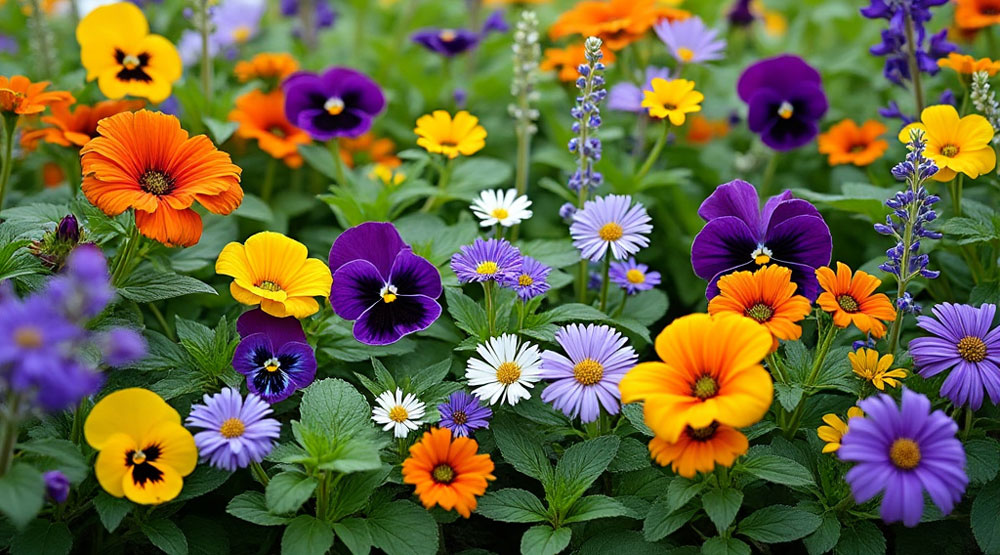
Imagine strolling through a garden where every bloom not only captivates your eyes but also offers a delightful addition to your meals. Edible flowers provide gardeners with the unique opportunity to blend aesthetics with gastronomy, transforming ordinary dishes into culinary masterpieces. From vibrant salads and creative entrées to fragrant teas and decadent desserts, these blossoms can elevate your everyday cuisine while enhancing the beauty of your garden.
Why Grow Edible Flowers?
- Aesthetic Appeal: Edible flowers turn gardens into vibrant canvases of color, fragrance, and texture.
- Culinary Delights: These flowers add unique flavors, aromas, and decorative touches to meals.
- Health Benefits: Many edible flowers are rich in vitamins and antioxidants.
- Ecological Benefits: Edible flowers attract pollinators, promoting a healthy garden ecosystem.
Popular Edible Flowers
- Nasturtiums (Tropaeolum majus): Peppery and slightly spicy flavor, vibrant red, orange, and yellow flowers.
- Pansies and Violas (Viola spp.): Mild, slightly sweet flavor, multi-colored delicate flowers.
- Lavender (Lavandula angustifolia): Strong, aromatic, slightly sweet, purple spikes.
- Borage (Borago officinalis): Mild cucumber-like taste, star-shaped blue flowers.
- Calendula (Calendula officinalis): Slightly bitter, tangy, and spicy, bright orange or yellow petals.
- Chamomile (Matricaria chamomilla): Mild, apple-like taste, small daisy-like flowers.
- Squash Blossoms (Cucurbita spp.): Mild, slightly sweet, large yellow or orange flowers.
- Roses (Rosa spp.): Fragrant, ranging from sweet to slightly spicy, classic blossoms in many colors.
- Violets (Viola odorata): Sweet and floral, small purple or white flowers.
- Chive Blossoms (Allium schoenoprasum): Mild oniony taste, small purple pom-pom-like flowers.
- Daylilies (Hemerocallis spp.): Sweet taste, similar to asparagus or zucchini, trumpet-shaped flowers in many colors.
Growing Edible Flowers
- Soil: Most edible flower plants prefer well-draining, fertile soil with a pH between 6.0 and 7.0.
- Sunlight: Provide full sun to partial shade depending on the species.
- Watering: Maintain consistent moisture without overwatering. Mulch can help retain moisture.
- Starting Seeds: Start seeds indoors 6-8 weeks before the last frost date or sow directly after frost.
- Companion Planting: Some edible flowers, like Nasturtiums, deter pests and enhance vegetable growth.
- Organic Practices: Avoid pesticides and chemical fertilizers for plants intended for consumption.
Harvesting and Using Edible Flowers
- Timing: Harvest flowers in the morning after the dew has evaporated.
- Technique: Use scissors or pruning shears to avoid damaging the plant.
- Preparation: Rinse flowers gently in cool water, and trim stamens and pistils from larger flowers.
- Storage: Use flowers immediately for the best flavor or store them in a damp paper towel in the fridge for up to a week.
Safety and Precautions
- Identify Correctly: Ensure that the flower species is edible and properly identified.
- Source: Only consume flowers you have grown yourself or that are certified for consumption.
- Pesticide Use: Do not consume flowers treated with non-FDA-approved pesticides.
- Allergies: Sample a small amount if trying a new edible flower to avoid adverse reactions.
Culinary Uses and Recipes
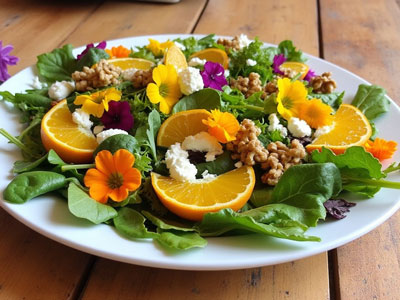
Nasturtium Salad with Citrus Vinaigrette
- 4 cups mixed salad greens
- 1 cup nasturtium leaves and flowers
- 1 orange, segmented
- 1/4 cup toasted walnuts
- 1/4 cup crumbled goat cheese (optional)
Prepare the vinaigrette by whisking orange juice, olive oil, honey, and Dijon mustard together. Combine mixed greens, nasturtium leaves, and orange segments. Drizzle with vinaigrette, and toss gently. Top with nasturtium flowers, walnuts, and goat cheese. Serve immediately.
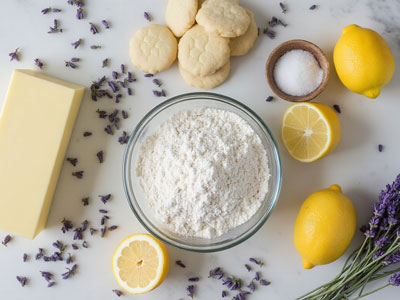
Lavender Lemon Shortbread Cookies
- 1 cup unsalted butter, softened
- 1/2 cup granulated sugar
- 2 cups all-purpose flour
- 2 tablespoons fresh lavender buds (or 1 tablespoon dried)
- Zest of 1 lemon
- Pinch of salt
Cream the butter and sugar until fluffy. Stir in the lemon zest and lavender, then add the flour and salt, mixing until combined. Form dough into a log, wrap in plastic, and refrigerate for 1 hour. Preheat the oven to 325°F (165°C). Slice the dough into rounds and bake for 15-18 minutes. Cool on a wire rack.

Borage and Cucumber Cooler
- 1 large cucumber, peeled and chopped
- 1/4 cup fresh borage flowers
- Juice of 2 lemons
- 4 cups cold water
- 1/4 cup honey or simple syrup
Blend the cucumber, borage, lemon juice, honey, and water. Strain into a pitcher, pour over ice, and garnish with borage flowers and a cucumber slice.
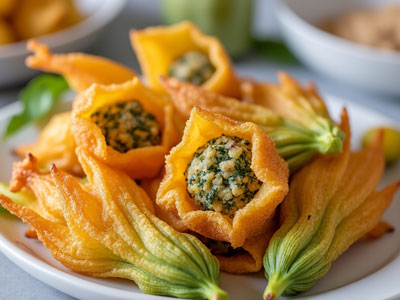
Stuffed and Fried Squash Blossoms
- 12 fresh squash blossoms
- 1 cup ricotta cheese
- 1/4 cup grated Parmesan cheese
- 1 egg yolk
- 2 tablespoons fresh basil, finely chopped
- 1 cup all-purpose flour
- 1 cup sparkling water
Mix the ricotta, Parmesan, egg yolk, basil, salt, and pepper. Stuff the blossoms, twist petals to close. Whisk flour and sparkling water for the batter. Dip the blossoms in batter and fry at 350°F (175°C) until golden. Drain on paper towels and serve warm.
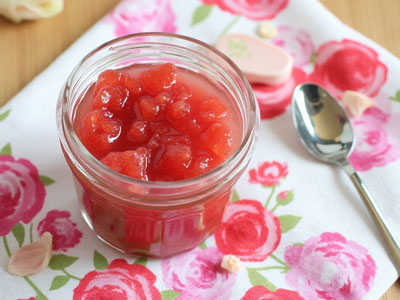
Rose Petal Jam
- 2 cups fresh rose petals, rinsed
- 2 cups granulated sugar
- 1/4 cup freshly squeezed lemon juice
- 1 1/2 cups water
Simmer water and sugar until dissolved. Add the rose petals and lemon juice, simmering until the mixture thickens to a jam-like consistency. Pour into sterilized jars and seal. Use on toast or pastries.

Chamomile Tea Infused Panna Cotta
- 2 cups heavy cream
- 1 cup whole milk
- 1/2 cup sugar
- 1/4 cup fresh chamomile flowers (or 2 tablespoons dried)
- 2 1/2 teaspoons unflavored gelatin powder
Simmer cream, milk, and sugar. Add chamomile, remove from heat, and steep for 15 minutes. Bloom gelatin in cold water, strain the cream mixture, and combine. Pour into molds and refrigerate until set.
Incorporating Edible Flowers Into Your Life
Incorporating edible flowers into your garden and kitchen opens up a whole world of beauty, flavor, and new experiences. Edible blossoms not only enhance the visual appeal of your outdoor spaces, but will bring unique tastes and creativity to your culinary endeavors. Impress your guests at a dinner party with edible blossoms or introduce them to a new dish at a pot-luck. Edible flowers offer endless possibilities for fun, exploration, and enjoyment.





























































































































































































































































































































































































































































































































































































































































